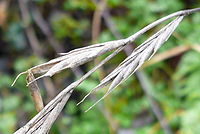
False Brome
Encyclopedia
Introduction
False Brome, Slender False Brome or Wood False Brome, Brachypodium sylvaticum, is a perennial grassPoaceae
The Poaceae is a large and nearly ubiquitous family of flowering plants. Members of this family are commonly called grasses, although the term "grass" is also applied to plants that are not in the Poaceae lineage, including the rushes and sedges...
native to Europe
Europe
Europe is, by convention, one of the world's seven continents. Comprising the westernmost peninsula of Eurasia, Europe is generally 'divided' from Asia to its east by the watershed divides of the Ural and Caucasus Mountains, the Ural River, the Caspian and Black Seas, and the waterways connecting...
, Asia
Asia
Asia is the world's largest and most populous continent, located primarily in the eastern and northern hemispheres. It covers 8.7% of the Earth's total surface area and with approximately 3.879 billion people, it hosts 60% of the world's current human population...
and north Africa
Africa
Africa is the world's second largest and second most populous continent, after Asia. At about 30.2 million km² including adjacent islands, it covers 6% of the Earth's total surface area and 20.4% of the total land area...
.

Description
It has drooping narrow long spikelets of flowers on very short pedicelPedicel (botany)
A pedicel is a stem that attaches single flowers to the main stem of the inflorescence. It is the branches or stalks that hold each flower in an inflorescence that contains more than one flower....
s and drooping leaves. Its awns are straight and 6 to 18 mm long, projecting out of the end of the spikelets. The flower head is 6 to 20cm long, the plant flowering in July and August
The leaf blade of the plant is dark green, or bright-yellow green, flat and up to 12 mm wide with a fringe of hairs surrounding the edge of the leaf. The leaves do not have auricles
Auricle (botany)
In botany, an auricle is a small ear-like projection from the base of a leaf or petal....
. The leaf blade is joined to the hollow culm by the leaf sheath. This hairy sheath is open and surrounds the culm. The culm is pilose (long, soft, hairy), and typically has 4 to 5 nodes.
The ligule
Ligule
A ligule — is a thin outgrowth at the junction of leaf and leafstalk of many grasses and sedges or a strap-shaped corolla, such as that of a ray floret in plants in the daisy family....
s are blunt, 1 to 6 mm long.
Wildlife Value
Its seeds can be dispersed by wildlife and humans. The caterpillarCaterpillar
Caterpillars are the larval form of members of the order Lepidoptera . They are mostly herbivorous in food habit, although some species are insectivorous. Caterpillars are voracious feeders and many of them are considered to be pests in agriculture...
s of some Lepidoptera
Lepidoptera
Lepidoptera is a large order of insects that includes moths and butterflies . It is one of the most widespread and widely recognizable insect orders in the world, encompassing moths and the three superfamilies of butterflies, skipper butterflies, and moth-butterflies...
use it as a foodplant, e.g. the Chequered Skipper
Chequered Skipper
The Chequered Skipper or Arctic Skipper , is a butterfly of the Hesperiidae family.-Description:This butterfly has a wingspan of 29 to 31 mm. The uppersides are a dark brown with a dusting of orange scales at the base of the wings and golden spots, giving it its English name of Chequered Skipper...
(Carterocephalus palaemon) and the Essex Skipper
Essex Skipper
The Essex Skipper is a butterfly of the Hesperiidae family. In North America, it is known as the European Skipper....
(Thymelicus lineola).
Invasive status in the Americas
It has been introduced to North AmericaNorth America
North America is a continent wholly within the Northern Hemisphere and almost wholly within the Western Hemisphere. It is also considered a northern subcontinent of the Americas...
and is considered a noxious weed in Oregon
Oregon
Oregon is a state in the Pacific Northwest region of the United States. It is located on the Pacific coast, with Washington to the north, California to the south, Nevada on the southeast and Idaho to the east. The Columbia and Snake rivers delineate much of Oregon's northern and eastern...
, USA.
Brachypodium sylvaticum is a newly-invasive brome species in Oregon that is rapidly expanding in the Pacific Northwest. This invasive grass has a broad native range stretching from North Africa to Eurasia (Hitchcock et al. 1969). Although B. sylvaticum appears to be in the early phases of invasion in North America, it has become noxious throughout the Willamette Valley area of Oregon in the last 20 years (Kaye 2001). It is speculated that B. sylvaticum was first introduced to Oregon in range experiments when accessions from the native range were planted at two locations in the Willamette Valley anywhere between 70 to 80 years ago (Rosenthal et al. 2008).
Recent observations suggest that populations at the leading edge of the expanding range undergo an establishment phase before they can contribute to the local invasion, perhaps because newly colonized populations are suffering from inbreeding depression.
False brome is an invasive species colonizing new areas and outcompeting native flora. As this species has spread to the Pacific Northwest it has demonstrated a capability of dominating forest understories and open grasslands to the exclusion of all other flora found in those areas.

